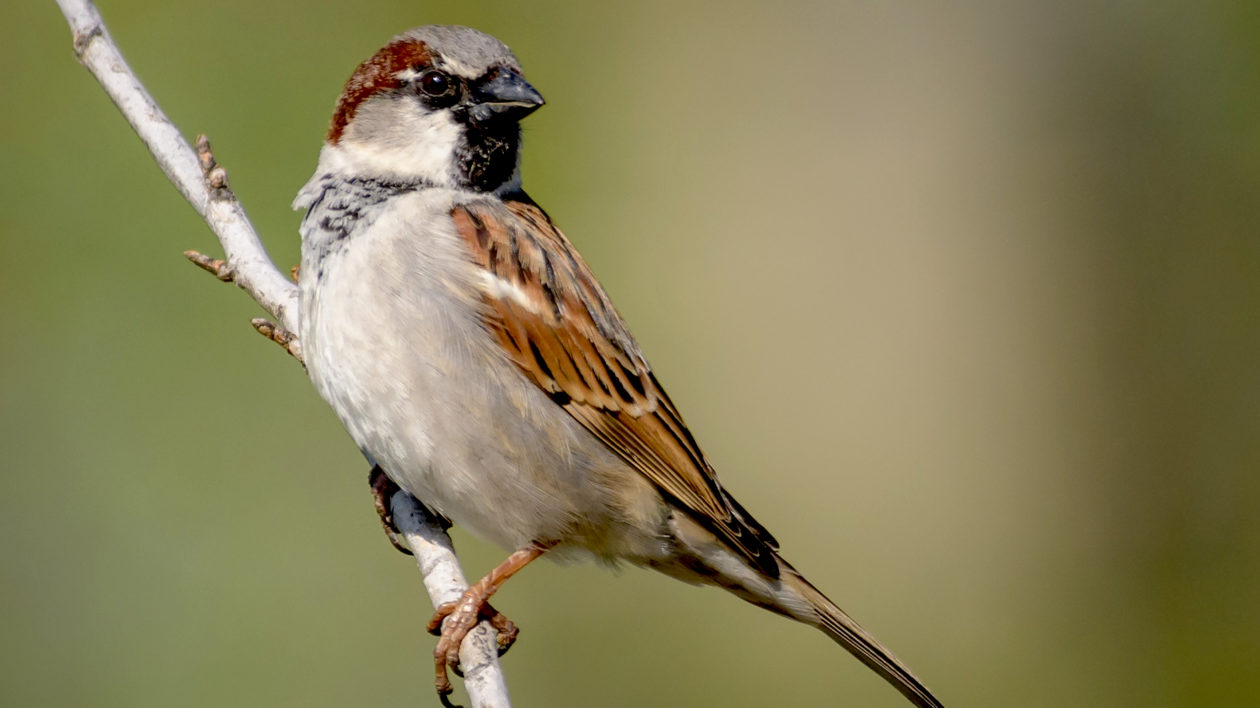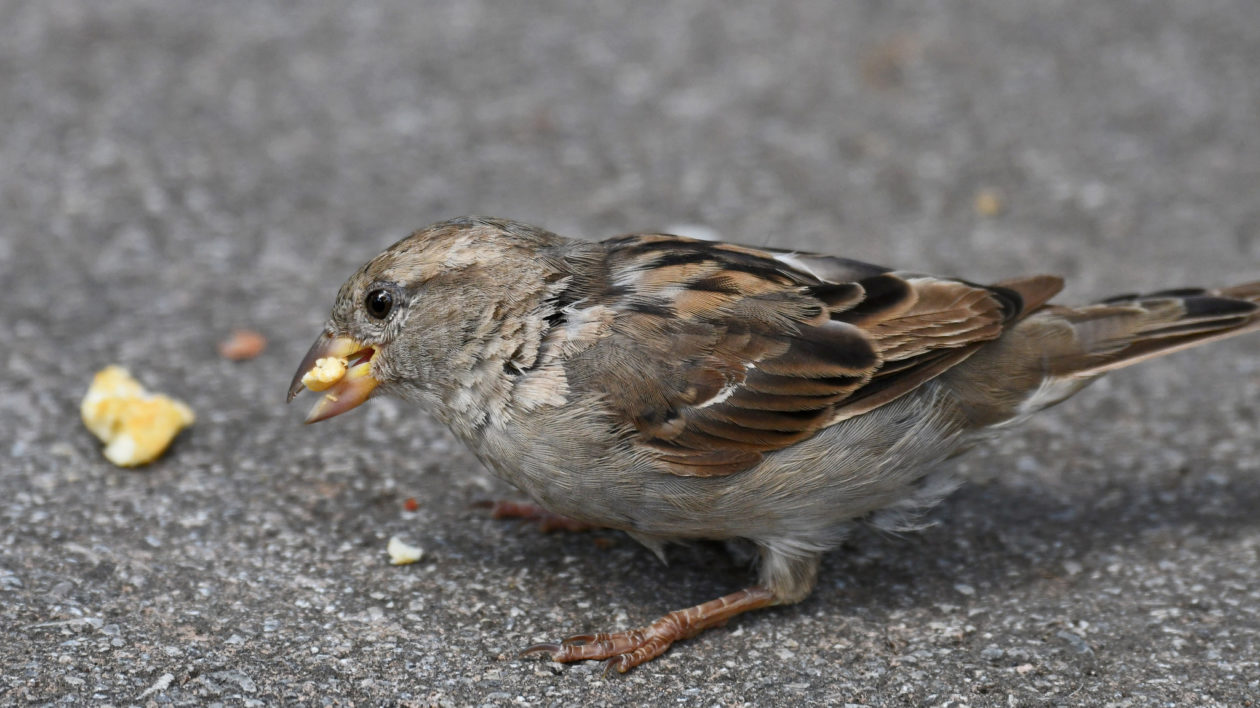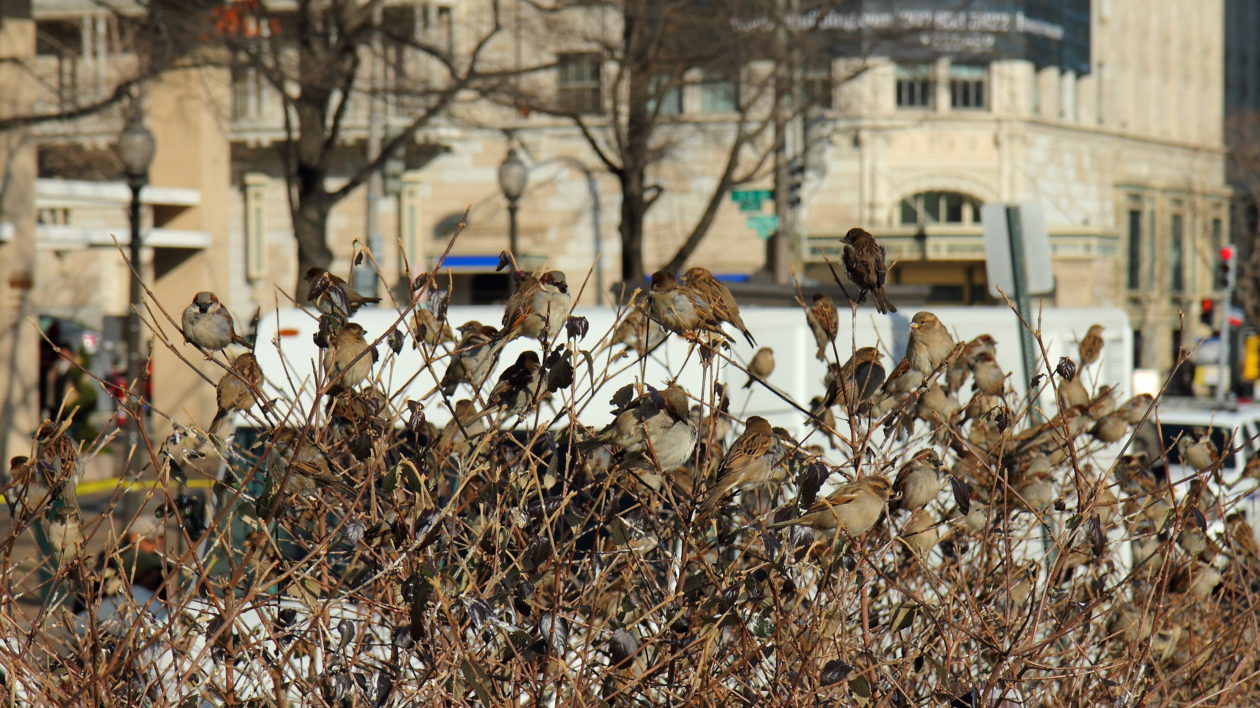I look out my window, and they’re everywhere: hundreds of house sparrows flit around our shrubs, hop around the yard, and steal food from our backyard chickens.
At this time of year, the males puff up and display, making them appear like much larger birds. They cheep incessantly, often drowning out other birdsong.
Given their constant presence, it seems odd to be writing this: House sparrow populations have been declining worldwide, including in their native range.
House sparrows are often considered one of the most adaptable birds, capable of thriving amongst our farms, suburbs and cities. The real story of their spread and decline is a bit more complex, and may have implications for urban conservation.
The Sparrow Fad
The house sparrow (Passer domesticus) is native to Eurasia, but beginning in the mid-1800s, it spread around the globe. Largely due to intentional releases by humans, house sparrows are now found on every continent except Antarctica, as well as many islands. It is the most widespread wild bird on earth.
As with many aspects of conservation history, many of the details of sparrow introductions are poorly documented. The first introduction to North America was to New York City in 1851 or 1852, although the 8 pairs released seemed to fare poorly. However, this set off a wave of introductions throughout the United States.
For a time, some sources refer to a “sparrow fad,” with private individuals breeding birds, and others catching them and releasing them into new areas. Nest boxes were installed in cities to increase sparrow populations. Ornithologists and others raised concerns over the merits of house sparrows, but their arguments proved futile against sparrow enthusiasts releasing cages full of birds.
The reason for many of these reasons was for pest control. For instance, their 1868 introduction to Philadelphia was apparently an effort to control inchworms. As with so many such pest control efforts, the cure proved worse than the disease. They thrive on a variety of foods, including spilled grain and even garbage.
The house sparrow is also an aggressive little bird. It nests in cavities, and pushed out native species like Eastern bluebirds. Backyard birders who erect birdhouses have undoubtedly noticed house sparrows bullying wrens and other native species.
Public sentiment turned quickly against the house sparrow. By the 1880s, just three decades after the first introduction, several U.S. cities paid bounties for the birds. But by then the bird was firmly established – and spreading.

Recent research published in the Proceedings of the Royal Society B found that house sparrows underwent genetic changes, including modified skull development and a gene that helps create the enzyme amylase that helps break down starch. The researchers hypothesized that these changes helped sparrows adapt to human settlements dominated by agricultural fields and livestock. The sparrows, according to the research, diverged from other Old World sparrows around 11,000 years ago, just as agriculture was taking hold in the Middle East.
The house sparrow appears to be a clear winner in the Anthropocene: an adaptable bird capable of thriving equally well on cities and in farms.
But over the past few decades, ornithologists have noted a new trend: house sparrows are in widespread decline. According to the Cornell Lab of Ornithology, house sparrow numbers in North America have declined by 84 percent since 1966. In Philadelphia, the city where the sparrows were introduced to control inchworms, the birds have largely disappeared.
Many birders view this as a good-news story. After all, house sparrows compete with native species and are generally viewed as a pest. However, the bird is experiencing similar declines in many parts of its native habitat, including the United Kingdom and Western Europe.
In England, house sparrow populations have declined by half. The species is listed by the Royal Society for the Protection of Birds as a species of high conservation concern. While the United Kingdom population has recently stabilized, the bird remains of concern to conservationists. European countries now recognize a World Sparrow Day to raise awareness of the plight of this once-abundant species.
What happened?

Sparrow Falling
Theories abound as to why house sparrows have declined. The answer likely lies in a combination of factors, all tied to rapid changes in both cities and farms. House sparrows may be highly adaptable, but that doesn’t mean they can thrive with every modification humans make to the environment.
The first house sparrow decline was actually reported in the 1920s, when automobiles began widely replacing horses. Sparrows feasted on the huge amount of spilled grain found in cities. When that food source was removed, sparrow populations decreased.
The Royal Society for the Protection of Birds and others note that changing agricultural practices likely play a significant role in the current sparrow decline. Once, farms were diverse, with crop fields and livestock barns scattered across the landscape. New, clean, intensified monocultures result in less spilled grain, and less cover around fields. In many parts of the world, other birds associated with farmland are also in decline.
Livestock is more frequently raised in confined operations, sometimes even indoors. All this results in fewer opportunities to feed on grain.
Similarly, city sanitary practices have improved, which may make finding meals more difficult for sparrows.
Research published in the journal Frontiers in Ecology and Evolution found that a combination of poor diet and air pollution induced physical stress on house sparrows, leading to reduced reproductive success.
The widely reported global insect decline may also be a significant factor. Many think of house sparrows as vegetarians, gobbling bird seed and grains. But, as with many birds, they rely on protein-rich insects to feed their young.

Implications for Urban Conservation
There are still 540 million house sparrows flying around the planet, so this bird is not in danger of going extinct. It’s still abundant in many places – including my neighborhood, where a mix of native vegetation, bird feeders and backyard chicken coops provide the diversity of habitat and food sources that enables these birds to thrive.
So why is the house sparrow decline important?
In part, it shows how little we understand urban ecology. Even conservationists often assume that common, adaptable species will be able to adapt to any change. That’s clearly not the case.
All ecosystems change, but human environments often change rapidly. If we’re thinking about protecting biodiversity in cities – and in a world that will have 9 billion people, we have to – we have to think about how changes impact wildlife. Just as modification to a tropical forest affects wildlife, so too do changes in farming practices, changes in city design, even changes in bird feeding habits.
I wouldn’t miss the house sparrow from my neighborhood. It’s an invasive species that competes with native birds. But globally, the sparrow’s decline is a story we should heed, as it may help us better understand how to coexist with nature in the Anthropocene.




Fascinating report. I had no idea the house sparrow is declining. I do believe we are all interconnected and that what happens to one species has impact on other species.
It remains a mystery to me how young scientific biologists and ecologists working with meta data can be totally blind to the basic truths any older person raised on a family farm knows…Yes, species are adaptable but NOT to very fast changes in the conditions that affect their basic needs…like food, water and nesting sites. The massive use of pesticides has decimated insects and all insect eaters. The move to industrial monoculture relies on pesticides/herbicides . The move to mechanized harvesting and indoor stock management has MASSIVELY reduced available food for seed eaters. In addition species (like sparrows, barn swallows etc) that requirea roof over their heads to nest have been decimated by our changing building standards and materials that are designed to provide no entry, by our felling trees with holes..WHERE are cavity nesters to go?…… Many of them are living in our attic and barn roof?…
I believe we would all miss their songs!
In Mount Dora, Fl many of our itches claim a battered favorite hanging plant that has been usurped by their current nest and a bit of a mess.
I can’t bring myself to mind. Their songs make that bit of bother worthwhile and sometimes they do a better job than I on scolding the next door cats off our front porch!
With the decline in House Sparrows in many urban areas, are they actually being replaced by other, preferably native, species, or is there a diminishment of birds overall?
If people are missing Sparrows, they should come to Baldwin, New York. We have scads of them. I don’t Notice any decline in them in the 50 years we’ve been here. On any given day there are 12 to 20 of them on our platform feeder, compared to 2 or 3 Chickadees, House Finches, Downy Woodpeckers, Nuthatches, etc. I must add that our Cardinal population is also large. On a good day we have 15 to 20.
Interesting article! Well done!
In Oak Park IL we have a thriving population. There is a large group the dive bombs from bushes on one side of the yard to shelter on the other. I limit my feeders to sunflower seeds and thistle to attract the cardinals and goldfinches. We have Mourning Doves, and Juncos pass through on migration. The one species really reduced from our regular horde is the goldfinch. We see far fewer of them than 5 years ago.
I have failed to find a satisfactory answer to what specifically urban folk can do to help revive the declining sparrow population. Any tried and tested suggestions?
Could the increase of Grackles and Pigeons contribute?
There should be a ban on inch worm pescidesit might be killing the butterfies as well
Here in NH the House Sparrows always were in my two neighbors hedges and would come over here to my feeders raising havoc with all my songbirds. They would take over the feeders and terrorize my nesting Wrens and Chickadees. I began putting branches over the top of the nest boxes and that helped as the male will sit atop the birdhouse he’s “claimed” and chirp his brains out. When he couldn’t sit on top they left the box alone. I always chase them away, they are indeed murderous birds and I’ve seen how they peck into the brains of Bluebirds, Chickadees and their young to take over a nest box. Last year at our cabin in Maine on a peninsula in the middle of nowhere came the House Sparrows! They tried to nest in my nest boxes and I wasn’t about to let them reproduce on MY watch! No way!! The Bluebirds had successfully fledged so I would prop open the nest box door – the House Sparrows would sit on top like idiots that couldn’t figure out how to get into the box when it was wide open. After emptying 5 nest boxes of their tangled mess of a nest they finally went away. I hope not to see any this year!! Here at home both neighbors got rid of those hedges so hopefully the House Sparrows found somewhere far away to set up residence so they stay out of my yard. Native birds have declined it’s plain to see for anyone who feeds them or bird watches…we don’t need these House Sparrows stealing their food and nests to make matters even worse.
In Seattle, English House Sparrows have all but disappeared and I don’t miss them. But it is sad to come across a lone sparrow calling and calling with no answer. House Finches have replaced them at the feeders and Juncos on the ground. Our native sparrows can get their fair share as well.
Here’s a suggestion to keep house sparrows out of your nest boxes: make sure the opening is large enough only for bluebirds and smaller cavity-nesting birds. House sparrows are bigger and if they can’t get into the nest box they can’t kill the nestlings. Check out various web sites about the right size for the opening of a nest box and buy/make a nest box specifically designed for bluebirds. Even if bluebirds don’t use it, chickadees or titmice might but no house sparrows.
Your statement that House sparrows cannot enter the correct size hole for a bluebird is totally incorrect. The correct size for eastern and western bluebirds is 1 1/2 inch, and it is easily accessed by House sparrows.
Sad that you wouldn’t miss the house sparrows – I would. Though they are invasive, they have certainly naturalized and have been a part of my life in every home I have lived in. They are a reliable part of our life and their loss would take away part of my outdoor family, not to mention the sadness I would feel knowing that it was caused by a decrease in an important part of their diet – insects. (And the effect on our greater world caused by loss of insects.)
I asked myself the same question a few days ago, when looking out our kitchen window, I wondered why I wasn’t seeing sparrows in the numbers I remember seeing by this time in the spring. I miss them, never did take them for granted, busy little birds, fun to watch.